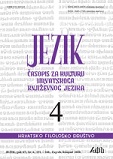Leksičko-semantička analiza dječjih iskaza u izražavanju osjećaja
Lexical and Semantic Analysis of Children’s Expressions in Feelings Expressing
Author(s): Katarina Aladrović Slovaček, Gordana Čosić, Ana MagašićSubject(s): Morphology, Lexis, Language acquisition, South Slavic Languages
Published by: Hrvatsko filološko društvo
Keywords: acquisition of language; language learning; feelings; lexical-semantic analysis; children’s speech;
Summary/Abstract: The process of acquisition of any language, including Croatian, begins in the womb when unborn children learn about the world around them by listening. From the first cry, the first unarticulated and then articulated sounds, over rhythmic pseudowords (logatomes), to the first words appearing around the child’s first year, the child gradually acquires the language to which it is exposed, in accordance with its psycho-cognitive development. The acquisition process is accompanied by a telegraphic form of speech without the use of immutable types of words and auxiliary verbs. There are no grammatical generalizations, discharge or replacement of sounds in words and neologisms, and children use communicators – lexemes in which at least one constituent differs from the lexeme uttered by an adult. Research results show that the foundation of the mother tongue is shaped around the child’s third year, and around the age of six, children can pronounce all sounds of the Croatian language, while the grammatical knowledge (morphology and syntax) is automated only about the age of twelve, when the phase of abstract thinking begins. In that early period, the child’s vocabulary is progressively growing; a six-year-old has a vocabulary of about 4000 to 6000 words, and by the time the child leaves school, the vocabulary grows annually by about 500 to 1000 new words. Enrichment of vocabulary is one of the goals of Croatian language teaching, although the strategy for achieving that goal does not really exist. That is why the aim of this paper is to examine which words and expressions are used by kindergarten, pre-school and younger schoolchildren in describing the feelings of happiness, sadness, anger and fear. The study includes ten children of kindergarten age (3-4 years), preschool (6-7 years) and younger school children (first and second classes). The results of interviews with the interviewees are recorded, transcribed and then analysed on the lexical-semantic and grammatical levels, with particular emphasis on the analysis of the used adjectives. The obtained results are compared in relation to the age group.
Journal: Jezik: časopis za kulturu hrvatskoga književnog jezika
- Issue Year: 67/2020
- Issue No: 4
- Page Range: 130-143
- Page Count: 14
- Language: Croatian

